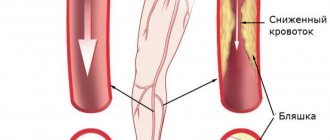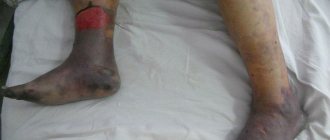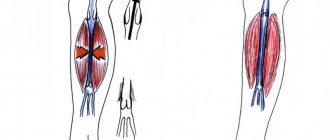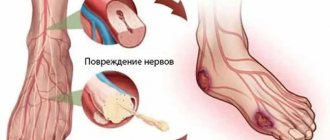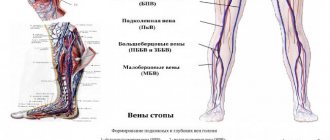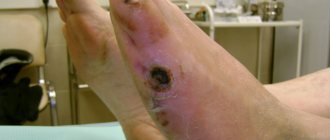Obliterating atherosclerosis is one of the main diseases that causes impaired blood supply to the lower extremities. The disease is associated with the accumulation of cholesterol in the artery wall, forming plaques that block the lumen of the artery. The arteries become hard and their patency is impaired. This pathology can lead to thrombosis of the affected artery with the development of acute ischemia. The disease usually develops in old age, often against the background of diabetes mellitus, although now relatively young patients also turn to a vascular surgeon.
Lack of blood supply leads to dysfunction of the muscles of the limb, this is manifested by fatigue when walking for some distance, and with severe decompensation of blood circulation, gangrene of the leg can develop.
Treatment of atherosclerosis at the Innovative Vascular Center
Our center was created as a clinic for modern treatment of atherosclerosis and its complications. In our clinic you can consult an experienced vascular surgeon and undergo the necessary instrumental examination. Receive recommendations for conservative treatment of uncomplicated vascular lesions, but the main thing is to fully cure critical ischemia with the help of vascular surgery.
The methods of vascular surgery used in our clinic have no analogues in Russia in terms of their effectiveness in the treatment of critical ischemia against the background of obliterating atherosclerosis. We focus on minimally invasive and microsurgical interventions, which have not yet become widespread in our country. We are able to save a leg in case of critical ischemia due to atherosclerotic blockage in 98% of all patients. We achieve such results thanks to reasonable approaches to treatment, impeccable attitude towards the interests of our patients, collegial decisions taking into account the opinions of related specialists and excellent diagnostic and treatment equipment.
Causes of atherosclerosis of the vessels of the lower extremities
There is a complex of factors that contribute to atherosclerotic vascular damage , including the arteries of the lower extremities. There are non-modifiable (that is, unchangeable) and modifiable (modifiable) risk factors. Non-modifiable risk factors include:
- age (the older you are, the stronger the manifestation of atherosclerosis);
- gender (men suffer from atherosclerosis much more often than women);
- genetic predisposition (if there are strokes and cardiovascular diseases in the family history, atherosclerosis is more likely).
Main modifiable risk factors
:
- disorders of lipid metabolism (increased levels of total cholesterol in the blood. A distinction is made between low-density lipoprotein cholesterol and high-density lipoprotein cholesterol. The threat of atherosclerosis increases with an increased content of low-density lipoprotein cholesterol and, conversely, with a reduced content of high-density lipoprotein cholesterol.);
- smoking;
- diabetes;
- obesity, overweight;
- high blood pressure (accelerates the development of atherosclerosis);
- sedentary lifestyle (leads to metabolic disorders);
- poor nutrition;
- renal failure.
For the development of atherosclerosis of the arteries of the lower extremities, smoking and diabetes mellitus are of greatest importance.
Diagnostics
To confirm the diagnosis and clarify the severity of the disease, additional diagnostic methods are needed:
- Ultrasound Dopplerography of the arteries of the lower limbs with measurement of the pressure ratio on the arm and leg, which normally should be close to unity
- duplex scanning of arteries of the artery is a method that allows not only to assess the blood flow in the vessel, but also to see the vessel itself and changes in its walls
- conducting stress tests (treadmill test, i.e. walking on a treadmill under certain conditions)
- according to indications, it may be necessary to conduct a contrast study of the arteries of the heart - multislice computed tomography or angiography of the aorta and arteries of the lower extremity
Doppler ultrasound
Ultrasound examination is the most common diagnostic method. This study is the first step towards studying human vascular diseases. Based on the ultrasound results, a further diagnostic and treatment plan is built.
Important: Smoking is prohibited before the ultrasound procedure. Smoking causes vasoconstriction, which leads to incorrect test results. And in general, before any diagnosis and testing, you should ask your doctor in advance how to prepare. This will help avoid unpleasant situations at the reception.
This is approximately how an ultrasound of the foot goes. Source: Vascular Online Training VOT / YouTube
Using ultrasound, it is possible to examine all changes in blood vessels, the degree of their narrowing or the presence of stenosis. Determine the localization and duration of atherosclerotic processes.
Symptomatic interventions:
- Sympathectomy
(intersection of the nerve plexuses responsible for spasm (narrowing) of the arteries) is performed for repeated blockages of the arteries and in addition to reconstructive operations. This operation improves blood circulation in the extremities by dilating small arteries. - Revascularization osteotomy
is also an adjuvant technique that improves blood circulation by stimulating the formation of new small vessels in the lower extremities after bone injury. - Arterialization of the venous bed
is rarely used at this time, since its implementation is associated with various technical difficulties, and long-term results are worse than the methods described above.
Symptoms of atherosclerosis of the vessels of the lower extremities
Atherosclerosis of the vessels of the lower extremities at an early stage can be practically asymptomatic. However, the absence of pronounced symptoms does not guarantee that atherosclerotic lesions are insignificant. Since lipid deposits in the walls of arteries do not immediately lead to disruption of blood flow, the development of atherosclerosis can go unnoticed for years.
If atherosclerosis develops slowly, the body compensates for the difficulty in blood flow through the main arteries with the help of collateral circulation, in which blood flows through the lateral branches of the arterial system. In this case, even a significant degree of atherosclerotic damage may not produce pronounced symptoms. The most striking symptom - intermittent claudication occurs only when the lumen of the artery is blocked by 80%.
The stage of development of atherosclerosis can be determined by how quickly pain occurs:
- Stage I
: pain in the legs occurs with significant physical activity. When walking calmly, pain occurs no earlier than after 1 km. ways. - Stage II
: pain occurs earlier than after 1 km. Moreover, if it arose more than 200 m later, we speak of stage II (A), and if less than 200 m later, we speak of stage II (B). - Stage III
: pain occurs every 25-50 m. At this stage, the legs hurt even at rest, especially at night. Patients usually lower their leg off the bed to improve blood flow and reduce pain. - Discomfort at rest is a critical indicator. The presence of discomfort indicates a high degree of stenosis or occlusion (complete closure of the lumen of the artery).
- Stage IV
is characterized by the appearance of ulcerative-necrotic changes. Feet become cold. Their hair falls out and their nails become deformed. Blackening of the skin occurs on the fingers and heels. Trophic ulcers develop. Possible gangrene.
Intermittent claudication
Intermittent claudication is pain in the calf muscles (less commonly, in the buttocks and thighs), as well as numbness and coldness of the lower extremities, forcing the patient to stop walking. It is enough just to stand in one place, the symptoms go away, and movement can continue.
Thromboangiitis obliterans (Buerger's disease)
The disease is quite rare. The course and clinical manifestations are similar to obliterating endarteritis, but differ in a more aggressive course. One of the main symptoms that distinguishes Buerger's disease from other obliterating diseases of the extremities is migrating thrombophlebitis, mainly of the superficial veins. The disease is characterized by a chronic course with periodic exacerbations and remissions.
Treatment of thromboangiitis obliterans is not much different from therapy for endarteritis obliterans. If venous thrombosis occurs, they are treated according to the general rules (see treatment of venous thrombosis).
Risk factors for OASNK
Atherosclerosis of the vessels of the lower extremities is characterized by the same risk factors as other arterial diseases, for example: coronary heart disease and cerebrovascular insufficiency.
- High blood pressure (hypertension),
- High blood cholesterol levels,
- Smoking,
- Sedentary lifestyle,
- Obesity,
- Burdened heredity.
A few words about smoking. Complete abstinence from any form of tobacco is necessary. Smoking even 1 cigarette per day of the lightest type is an unfavorable risk factor that causes the progression of obliterating atherosclerosis of the lower extremities and the development of its severe complications. The nicotine contained in tobacco causes the arteries to spasm, thereby preventing blood from moving through the vessels and increasing the risk of blood clots in them.
Surgical techniques
Surgery is a last resort and is usually prescribed for severe ischemia and very severe complications. Nowadays, different types of surgical interventions are performed. Some involve a day hospital, some require a long-term hospital stay under observation. Patient rehabilitation plans and post-operative care vary. Our doctors advise patients in detail on all aspects related to surgical intervention and carefully monitor their health in the pre- and postoperative period.
Surgical treatment of atherosclerosis of the lower extremities:
- bypass surgery - an additional “bypass” path for blood flow is created around the area of narrowing of the artery;
- stenting - a special tubular spacer is placed in the affected vessel, which ensures the required diameter of the artery;
- balloon angioplasty - similar to stenting, only a balloon is inserted into the vessel cavity rather than a spacer, which expands its lumen;
- autodermoplasty - if trophic ulcers are poorly treated conservatively, they are operated on and covered with the patient’s own skin;
- endarterectomy - removal of the affected part of the artery in which the atherosclerotic plaque is located;
- prosthetics – replacement of the affected vessel with the patient’s own vein, taken from another place, or with a synthetic prosthesis;
- amputation - prescribed in severe cases when gangrene occurs, after which prosthetics are performed.
In 75-85% of cases, after surgery, blood circulation is completely restored for an average of 5-8 years.
Indications for surgery:
- an aneurysm that may rupture;
- chronic ischemia of critical stage;
- hemodynamically significant carotid artery stenosis or plaque accompanied by symptoms of cerebral ischemia;
- decompensation of blood circulation in the leg due to embolism, trauma, thrombosis.
Contraindications to surgical treatment:
- wet gangrene with sepsis;
- severe disruption of vital organs - renal and liver failure, circulatory disorders in the brain, myocardial infarction, heart failure, etc.
Prognosis and prevention
Source: PhotoMIX Company: Pexels
The effectiveness of treatment and the overall prognosis for obliterating atherosclerosis depend on the time of initiation of therapy, the degree of arterial damage and the presence of concomitant pathologies. Therapy is particularly difficult when other vessels, cerebral or coronary, are simultaneously affected.
The most dangerous complication of the disease is gangrene, which has a high probability of death. Its development can only be prevented by emergency amputation of the affected limb.
Prevention measures are aimed at reducing the risk of developing atherosclerosis and include the following recommendations:
- normalize your diet and give up high-fat foods;
- do not smoke or drink alcoholic beverages;
- devote time to moderate physical activity, such as swimming, cycling or even just walking;
- keep your feet clean;
- wear comfortable shoes with low heels;
- Avoid injuries and cuts to the skin on your legs.
Timely treatment can stop the development of the pathological process and significantly improve the patient’s quality of life.
Pathomorphology
The main changes develop in the intima of the arteries. There are 5 morphological stages of atherosclerosis:
- Prelipidic – characterized by increased endothelial permeability, destruction of the basement membrane, destruction of elastic and collagen fibers.
- Stage of lipoidosis - focal infiltration of the arterial intima with lipids occurs.
- Stage of liposclerosis - a fibrous plaque forms in the intima of the artery.
- Stage of atheromatosis - destruction of the plaque occurs with the formation of an ulcer.
- Stage of atherocalcinosis – plaque calcification occurs.
Based on the type of damage to the vascular bed, segmental and diffuse atherosclerosis are distinguished. In the first case, the process develops in a limited area of the vessel from single plaques to complete occlusion of the lumen. This type is more favorable in terms of the potential for performing bypass reconstructive operations on blood vessels. The diffuse type involves widespread atherosclerotic lesions predominantly in the distal bed, leaving no “window” for the surgeon to apply a shunt or prosthesis. The destiny of such patients is conservative therapy in order to delay the onset of gangrene as much as possible.
